Taddeo di Bartolo stands as a pivotal figure in the Sienese school of painting, an artist whose prolific career spanned the late 14th and early 15th centuries. Active during a period of significant artistic transition, his work embodies both the rich traditions of Sienese Gothic art and the burgeoning humanistic impulses that would come to define the Early Renaissance. Born in Siena around 1362 or 1363, he died in the same city in August 1422, leaving behind a substantial body of work that adorned churches and civic buildings across Tuscany and beyond.
Early Life and Artistic Formation in Siena
Taddeo was the son of Bartolo di Mino, a barber, a profession that, in medieval and Renaissance Italy, sometimes overlapped with minor artistic practices or guild affiliations that included painters. Siena, his birthplace, was a vibrant artistic center, second only to Florence in Tuscany. The city prided itself on a distinct artistic lineage, characterized by elegant lines, rich colors, and a lyrical, often courtly, sensibility. This tradition was established by masters like Duccio di Buoninsegna at the turn of the 14th century, whose Maestà altarpiece for the Siena Cathedral was a landmark of Italian art.
Following Duccio, Simone Martini further refined Sienese elegance, infusing it with a sophisticated International Gothic style that resonated across Europe. The Lorenzetti brothers, Pietro and Ambrogio, introduced a greater sense of naturalism, emotional weight, and spatial depth, famously demonstrated in Ambrogio's frescoes of "Good and Bad Government" in Siena's Palazzo Pubblico. These artists, along with later Sienese painters like Bartolo di Fredi and Andrea Vanni, formed the rich artistic soil from which Taddeo di Bartolo's own talents would spring.
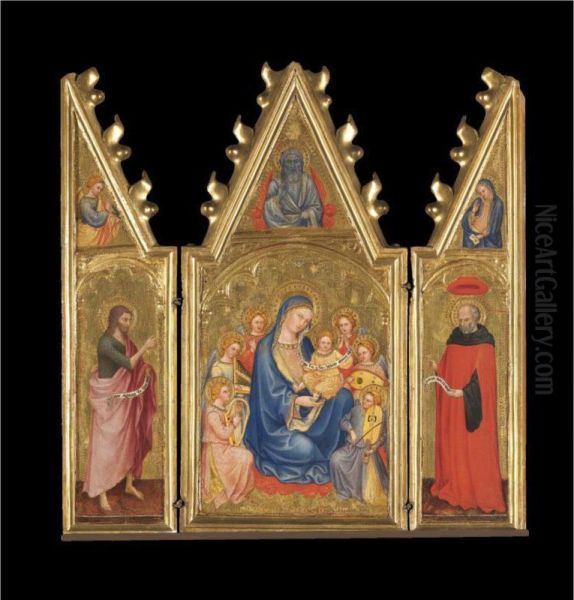
The precise details of Taddeo's early training are not definitively documented, a common situation for artists of this period. However, it is highly probable that he apprenticed in one of the active Sienese workshops. His style shows an understanding of the Lorenzetti tradition, particularly in its narrative clarity and emotional directness, though he developed a more robust and sometimes sterner figural style than many of his Sienese predecessors. He is first documented as an independent painter in 1389, suggesting his training was completed by this time. An earlier record from 1386 notes him as a member of the Siena Cathedral choir, an interesting detail that might suggest a multifaceted involvement in the city's religious life.
The Sienese Artistic Milieu and Early Career
By the time Taddeo di Bartolo emerged as an independent master in 1389, Sienese art was well-established, yet also facing new challenges and influences. The Black Death of 1348 had profoundly impacted all aspects of European society, including artistic production and patronage. While Siena continued to commission significant works, the artistic fervor of the early 14th century had somewhat tempered. Taddeo's generation of artists, including contemporaries like Paolo di Giovanni Fei and Martino di Bartolomeo, worked to uphold and adapt the Sienese tradition.
His first securely dated work is a polyptych, the "Virgin and Child with Saints," painted in 1389 for the chapel of San Paolo at Collegarli, near San Miniato al Tedesco. This work already demonstrates his characteristic style: strong, clearly defined figures, a rich palette, and a direct, unpretentious piety. The influence of earlier Sienese masters is evident, but Taddeo's own artistic personality – one of vigor and clarity – is already present.
His Sienese commissions were significant. For the Siena Cathedral, he executed important works, including a triptych of the "Madonna and Child" (1389), showcasing his ability to work on a grand scale for the city's most important religious edifice. His involvement with the Cathedral workshop indicates his respected status within the Sienese artistic community.
Major Commissions and Extensive Travels
Taddeo di Bartolo was not an artist confined to Siena. His reputation led to numerous commissions from other cities, making him one of the most widely traveled Sienese painters of his time. This mobility exposed him to different artistic currents and allowed him to disseminate the Sienese style more broadly.
Around 1393, Taddeo was in Genoa, where he worked on an altarpiece for the church of San Luca, collaborating with the local painter Luchino da Milano. His Ligurian sojourn also included work for Francesco Lomellini, a prominent Genoese patron. This period demonstrates his adaptability and the demand for his skills outside Tuscany.
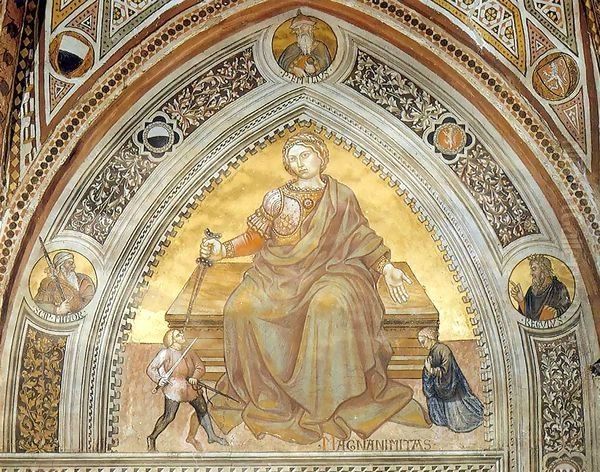
Pisa was another important center for Taddeo's activity. Between 1395 and 1397, he painted frescoes in the Camposanto (the monumental cemetery) and created altarpieces for Pisan churches, including a significant polyptych for the church of San Francesco. His Pisan works show him engaging with the local artistic traditions, which had been shaped by figures like Francesco Traini.
Perhaps his most famous frescoes outside Siena are those in the Collegiata (Collegiate Church) of San Gimignano, executed around 1393 (though some scholars date them slightly later, to the early 1400s). Here, on the internal facade and side walls, he painted a dramatic "Last Judgment," complete with vivid depictions of Paradise and a particularly gruesome Hell. These frescoes, with their didactic power and expressive force, are a testament to Taddeo's skill in large-scale narrative mural painting. The graphic portrayal of the torments of the damned served as a potent moral warning to the congregation.
Further commissions took him to Montepulciano, where he painted a large polyptych for the Duomo (Cathedral) in 1401, depicting the "Assumption and Coronation of the Virgin." This altarpiece is one of his most celebrated panel paintings, noted for its monumental figures and rich, Sienese coloration. He also worked in Perugia, creating a "Pentecost" altarpiece for the church of Sant'Agostino around 1403, now in the Galleria Nazionale dell'Umbria. His presence in Umbria brought Sienese influence to a region also receptive to Florentine art.
Volterra was another city where Taddeo left his mark, notably with a polyptych for the Duomo. His travels extended even to Rome, where he is documented as having worked, although specific surviving works there are less securely attributed or have been lost. This extensive itinerary underscores his reputation and the demand for his particular brand of robust, narrative Sienese painting.
The Chapel of the Palazzo Pubblico, Siena
One of Taddeo di Bartolo's most significant and best-preserved fresco cycles is in the antechapel (or Cappella dei Signori) of the Palazzo Pubblico, Siena's town hall. Executed between 1406 and 1414, these frescoes depict scenes from the "Life of the Virgin" alongside monumental figures of ancient Roman heroes and allegorical representations of virtues. This juxtaposition of sacred and secular themes was characteristic of Sienese civic humanism.
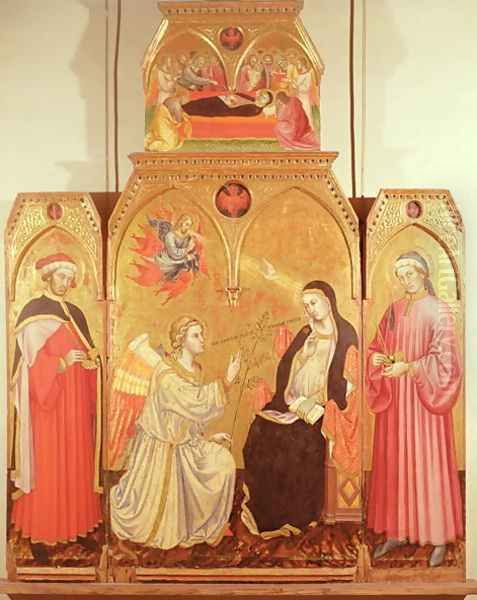
The Roman heroes – figures like Cicero, Cato, Scipio Africanus, and Marcus Curius Dentatus – were presented as exemplars of civic virtue, courage, and justice, intended to inspire the Sienese councillors who met in these rooms. Taddeo's portrayal of these figures is powerful and statuesque, reflecting a growing interest in classical antiquity that was a hallmark of the early Renaissance. The accompanying inscriptions further emphasized their moral qualities.
The religious scenes, including the "Death of the Virgin" and the "Assumption," are rendered with Taddeo's characteristic emotional directness and narrative clarity. The entire decorative scheme of the antechapel is a complex program designed to promote good governance and piety, reflecting the intertwined nature of religious and civic life in Siena. These frescoes are considered among his masterpieces and are crucial for understanding his mature style and his contribution to civic art.
Artistic Style and Techniques
Taddeo di Bartolo's style is a fascinating blend of Sienese tradition and his own robust, somewhat conservative, yet powerful artistic personality. He inherited the Sienese love for elegant contours, decorative patterns, and expressive figures. However, his figures often possess a greater solidity and a more down-to-earth quality than the ethereal creations of Simone Martini or the more delicate figures of some of his Sienese contemporaries.
His compositions are generally clear and well-organized, with a strong narrative focus. He was adept at conveying emotion, though often in a direct and somewhat unidealized manner. In his depictions of sacred stories, he aimed for legibility and devotional impact. His "Last Judgment" in San Gimignano, for instance, is less about subtle theological points and more about a visceral presentation of divine reward and retribution.
Taddeo was proficient in both fresco and tempera on panel, the two dominant painting techniques of his era. His panel paintings, often large polyptychs, feature rich colors, extensive use of gold leaf for backgrounds and halos (a hallmark of Sienese tradition), and carefully rendered details in drapery and ornamentation. His fresco work demonstrates his ability to manage large wall surfaces and complex narrative cycles. While not an innovator in perspective on the level of his Florentine contemporaries like Masaccio (who came slightly later), Taddeo did employ empirical perspective to create a sense of space in his scenes.
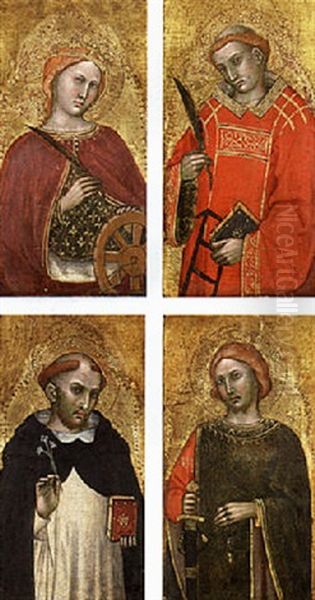
Some art historians have characterized his style as somewhat "coarse" or lacking in the refined grace of earlier Sienese masters. However, this assessment perhaps overlooks the strength and directness that were Taddeo's hallmarks. His art possessed a vigor and a narrative power that clearly appealed to a wide range of patrons, both civic and religious. He was a highly skilled craftsman whose workshop was capable of producing a large volume of high-quality work.
Collaborations, Workshop, and Rivalries
Like most successful artists of his time, Taddeo di Bartolo likely maintained an active workshop to assist with the numerous commissions he received. His nephew, Domenico di Bartolo, who would later become a significant Sienese painter in his own right, is believed to have received his early training in Taddeo's workshop. Another artist sometimes associated with him as a pupil or follower is Gregorio di Cecco.
Collaboration was common. As mentioned, he worked with Luchino da Milano in Genoa. He also had a documented collaboration with Francesco di Michelangelo on frescoes in the Saliceto Castle. Such partnerships were practical necessities for large projects or when working in unfamiliar locales.
The art world of 14th and 15th-century Italy was also competitive. Artists vied for prestigious commissions and patronage. Taddeo's career was not without its frictions. Historical records indicate a dispute with the Sienese painter Martino di Bartolomeo, for which Taddeo was fined. This incident suggests a somewhat contentious personality or, at the very least, the normal professional rivalries of the period. He also faced competition from other established Sienese painters like Spinello Aretino (though primarily Florentine, Spinello worked in Siena) and later, younger talents. His ability to secure major commissions in Siena and numerous other cities, despite such competition, speaks to his recognized skill and reputation. He was also in competition for patronage with figures like Pietro Gallo and Barnaba da Modena, reflecting the dynamic and sometimes tense environment of artistic production.
Notable Works: A Summary
Taddeo di Bartolo's oeuvre is extensive. Some of his most significant and representative works include:
Polyptych of the Virgin and Child with Saints (1389): For San Paolo, Collegarli. Now dispersed, with panels in various collections.
Madonna and Child Triptych (c. 1389): Siena Cathedral.
Madonna and Angels: Now in the Louvre Museum, Paris.
Frescoes of the Last Judgment, Paradise, and Hell (c. 1393-1400s): Collegiata, San Gimignano. These are among his most impactful and well-known fresco works.
Altarpiece for San Francesco, Pisa (c. 1395-1397): Parts of this polyptych are now in various museums.

Polyptych of the Assumption and Coronation of the Virgin (1401): Duomo, Montepulciano. A major altarpiece, showcasing his mature panel painting style.
Pentecost Altarpiece (1403): Originally for Sant'Agostino, Perugia. Now in the Galleria Nazionale dell'Umbria, Perugia.
Frescoes in the Antechapel (Cappella dei Signori) (1406-1414): Palazzo Pubblico, Siena. Depicting the Life of the Virgin, Roman Heroes, and Virtues. This is arguably his most important surviving fresco cycle.
Madonna and Child with St. John the Baptist (1395): An example of his devotional panels.
The Crucifixion with the Virgin, Saint John the Evangelist and a Female Donor Figure: Perugia National Gallery (though the dating to 1362/7 seems very early for Taddeo and might refer to a different artist or an early, undocumented phase).
Madonna and Child with Saints Andrew, Peter, James the Greater, and Thomas (1398): A polyptych, with panels now in the Musée de Grenoble, France, and possibly connected to works in the Church of San Marco, Siena, or other collections. The exact configuration and original location of all parts of such large, often dismembered, altarpieces can be complex for art historians to reconstruct.
Many other panel paintings, including numerous "Madonna and Child" images, fragments of polyptychs, and smaller devotional works, are attributed to Taddeo and his workshop, found in museums and collections worldwide, such as the Memphis Brooks Museum of Art and the New Orleans Museum of Art.
Influence and Legacy
Taddeo di Bartolo played a significant role in Sienese painting at the turn of the 15th century. He was a prolific and highly respected master who successfully adapted the Sienese tradition to meet the demands of his time. His robust style, narrative clarity, and ability to work on a monumental scale ensured his popularity with a wide range of patrons.
His most direct artistic heir was his nephew, Domenico di Bartolo, who became a leading painter in Siena in the 1430s and 1440s. Domenico absorbed elements of Taddeo's style but also embraced the newer, more naturalistic and perspectivally sophisticated trends emerging from Florence, particularly from artists like Filippo Lippi and Fra Angelico.
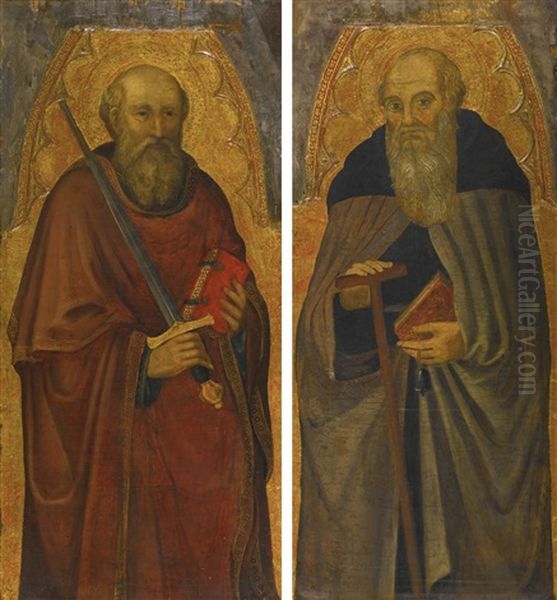
Taddeo's influence extended beyond his direct pupils. His work provided a model of solid, professional craftsmanship for other Sienese artists. While Sienese painting in the 15th century would increasingly look to Florentine innovations, figures like Sassetta (Stefano di Giovanni) and Giovanni di Paolo, who defined the Sienese Quattrocento, still operated within a tradition that Taddeo had helped to shape and sustain. His emphasis on expressive figures and rich decorative qualities remained a feature of Sienese art.
More broadly, Taddeo's career exemplifies the vitality of regional artistic schools in Italy during this period. While Florence was a powerhouse of innovation, Siena maintained its own distinct artistic identity, and Taddeo was a key exponent of that identity. His extensive travels also facilitated artistic exchange between Siena and other Italian centers.
Critical Reception and Historical Controversies
Historically, Taddeo di Bartolo's reputation has been somewhat overshadowed by the giants of the earlier Sienese Trecento (like Duccio, Simone Martini, and the Lorenzetti) and by the Florentine innovators of the Early Renaissance. Some 20th-century critics, such as Bernard Berenson, while acknowledging his productivity, sometimes characterized his art as somewhat provincial or lacking in the highest degree of artistic inspiration, occasionally describing his technique as "weak" or his style as "coarse."
However, more recent scholarship has tended to re-evaluate Taddeo's contribution more positively, recognizing the strength, expressiveness, and narrative skill of his work, particularly his frescoes. His ability to manage large-scale commissions and his role in civic art, as seen in the Palazzo Pubblico, are now better appreciated. The directness and emotional honesty of his religious imagery also find more sympathetic viewers today.
Controversies regarding Taddeo di Bartolo often revolve around attribution. Given the scale of his workshop and the number of commissions, distinguishing between the master's hand, workshop participation, and works by followers can be challenging. The dismemberment of many of his large polyptychs over the centuries further complicates the study of his oeuvre.
His documented personality, described as somewhat difficult or outspoken, as evidenced by fines for altercations, adds another layer to his historical image. This "prickly" character, however, did not seem to impede his ability to secure and execute major commissions across Italy, suggesting that his artistic talents were highly valued. The perception of his works as sometimes being "utilitarian" rather than luxury items might have contributed to a lower survival rate for some of his output compared to more lavishly produced pieces.
Conclusion: A Master of Transition
Taddeo di Bartolo was a formidable artistic presence in late Trecento and early Quattrocento Italy. As a leading master of the Sienese school, he upheld its traditions of linear elegance and expressive intensity while forging a distinctive style characterized by vigor, narrative clarity, and a certain down-to-earth robustness. His extensive travels and numerous commissions across Tuscany, Liguria, Umbria, and beyond attest to his widespread reputation.
His frescoes in San Gimignano and, most notably, in the Palazzo Pubblico in Siena, stand as powerful examples of late medieval and early Renaissance mural painting, conveying complex religious and civic messages with directness and force. While perhaps not an innovator on the scale of some of his Florentine contemporaries, Taddeo di Bartolo was a master of his craft, a significant transitional figure whose work provides a vital link in the continuity of Sienese art and reflects the broader artistic currents of a changing Italy. His legacy endured through his pupils and through the distinctive character he imparted to the Sienese artistic tradition at a crucial juncture in its history.